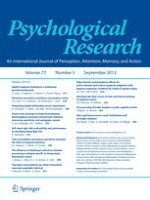01-04-2004 | Original Article
Response priming by supraliminal and subliminal action effects
Gepubliceerd in: Psychological Research | Uitgave 2-3/2004
Log in om toegang te krijgenAbstract
Theories assuming an effect-based coding of action predict that motor responses become activated by the perception of the responses’ sensory effects. In accordance with this prediction it was found that responding to a visual target is faster and more accurate when the target is briefly preceded by the visual effect of the required response. Most importantly, this effect-induced response priming was independent of prime perceptibility and it occurred even when the prime was not consciously discriminable. Beyond ruling out alternative interpretations of earlier induction studies in terms of deliberate response biases, this suggests that effect codes evoke their associated motor patterns in a highly automatic manner not affording conscious mediation. The results accord with a functional dissociation between the consciousness-mediated implementation and the consciousness-independent realization of action goals.
